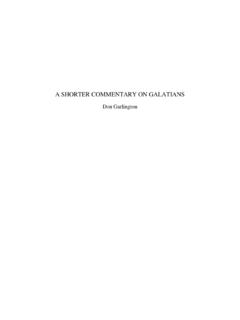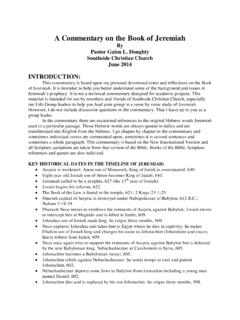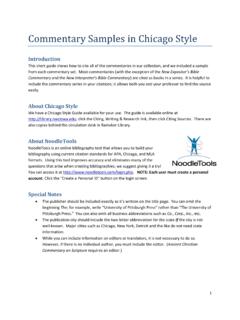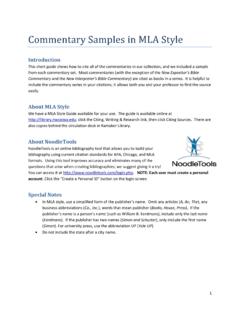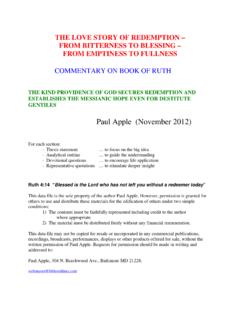Transcription of A SHORTER COMMENTARY ON GALATIANS - …
1 A SHORTER COMMENTARY ON GALATIANS Don Garlington CONTENTS Preface iii Introduction 1 GALATIANS Chapter One 23 GALATIANS Chapter Two 54 GALATIANS Chapter Three 91 GALATIANS Chapter Four 117 GALATIANS Chapter Five 138 GALATIANS Chapter Six 169 iii PREFACE This volume is a SHORTER , less technical version of my COMMENTARY on GALATIANS , An Exposition of GALATIANS : A Reading From the New Perspective (3rd ed.; Eugene, OR: Wipf & Stock, 2007). Naturally, such an abbreviated edition of a 440 page work cannot address all the issues of the larger recension.
2 Nevertheless, the essence of the exposition is present, and it is hoped that such a treatment of GALATIANS will be of use to pastors and missionaries in particular. References to commentaries on GALATIANS are by authors last names, with other literature cited in an abbreviated form. Full information is provided by the bibliography (in the Introduction). Don Garlington Toronto, Ontario 1 INTRODUCTION The purpose of this introduction is to focus attention on the historical/theological issues that formed the context of the Galatian letter and gave rise to its production.
3 Questions such as authorship, date, place of writing and destination are interesting in themselves. But apart from authorship, there continues to be uncertainty on all these points, and it is extremely unlikely that any unanimity will ever be reached. Besides, the resolution of these issues is hardly indispensable to the interpretation of the epistle s biblical-theological content. Adequate discussions can be found in the introductions to each of the commentaries cited throughout this work, to which I would add, among others, Brown, Introduction, 467-82; Gorman, Apostle, 183-226; Hansen, DPL, 323-34; Carson/Moo/Morris, Introduction, 289-303.
4 An oft-discussed matter is the relation of GALATIANS to Paul s trip to Jerusalem as related in Acts 11:27-30 and the apostolic conference of Acts 15. Witherington s discussion is as good as any (Witherington, 13-20), and in the section note to 2:1 a reconstruction is likewise offered. To be sure, from the sociological point of view, it would be helpful to pinpoint the precise location of the Galatian churches. But even with relative uncertainty, we may assume that the readers, wherever they were, had come under the pervasive influence of the emperor cult and, in all probability, had experienced firsthand the worship of the Anatolian Mother Goddess (see White, Apostle, chaps.)
5 4, 5, 7; Horsley (ed.), Paul; W. Carter, Matthew; Witulski, Adressaten, 128-75; Elliot, Mother ). The broader missionary context of GALATIANS is set by Hultgren, Gospel; O Brien, Gospel; Bolt/Thompson (eds.), Gospel; K stenberger/O Brien, Salvation, 161-201. Methodological questions are addressed by Silva, Explorations, and Wright, Exegesis. An ever burgeoning field of research of late has been Paul s presumed dependence on the canons of Greco-Roman rhetoric, as exemplified prominently by Quintilian. This rhetorical reading of GALATIANS has particularly influenced the commentaries of Betz and Witherington.
6 My own judgment is that while Paul probably had some training in rhetoric, the categories have been greatly overworked, and the results have proven to be largely artificial. The definitive challenge to the growing consensus that GALATIANS is cast in the mold of the rhetorical handbooks is provided by Martyn, 20-27; and especially Kern, Rhetoric. 1. Occasion and Purpose of the Letter The letter to the GALATIANS mirrors the first major crisis in the life of the infant church. The issue is simply stated. According to Acts 15:1, certain Jewish Christians were insisting that unless Gentile converts to Christianity are circumcised according to the custom of Moses, they cannot be saved.
7 But this demand on the part of former Pharisees, now reckoned among the Christian community, was extended beyond circumcision to the observance of the whole law of Moses (Acts 15:5; cf. Gal 5:3). In short, according to the circumcision party, anyone wishing to join the ranks of the people of God from the outside must, with few exceptions, conform to the normal procedure prescribed for proselytes circumcision and commitment to Israel s Torah (see Sch rer, History, ; Donaldson, Paul, 54-65). 2 Luke terms this company believers, presumably because its adherents accepted Jesus as the Messiah and came to recognize that the age of the Spirit had arrived with him.
8 Nevertheless, in focus and commitment, these people apparently brought their Pharisaic presuppositions over into their Christianity. According to that set of assumptions, Israel s law was eternal and unchangeable, and the Messiah himself was conceived of as a servant of the Torah. His job was to preserve intact the values of God s covenant with Israel and to eliminate all opposition to the contrary (as classically affirmed in Psalms of Solomon 17-18). In the Acts narrative, the insistence on circumcision and the law represents the climax of a story, namely, the struggle for Gentile equality in the assemblies of Jesus the Christ.
9 The issue is posed by Boice. When the gospel was being preached primarily to Jews by Jews, the development of the church progressed smoothly. But as Christians pushed out into largely Gentile communities and the gospel began to take root there, questions arose regarding a Christian s relationship to the law of Moses and to Judaism as a system. Was the church to open her doors wide to all comers, regardless of their relationship to the particularized traditions of Judaism? Were her boundaries to be as wide as the human race?
10 Or was she to be only an extension of Judaism to the Gentiles (Boice, 409)? By the time the apostolic conference of Acts 15 concludes, the apostles and other participants arrive at a consensus: Gentiles are not to be unnecessarily burdened by the Mosaic regulations; they need only abstain from immorality and idolatry (see Witherington, Acts, 460-67). Effectively, they said, being Christian does not hinge on first becoming Jewish. Paul s letter to the GALATIANS marks the early stages of the controversy. The party whose positions were finally rejected by the Jerusalem church was actively engaged in missionary activity for a number of years.
